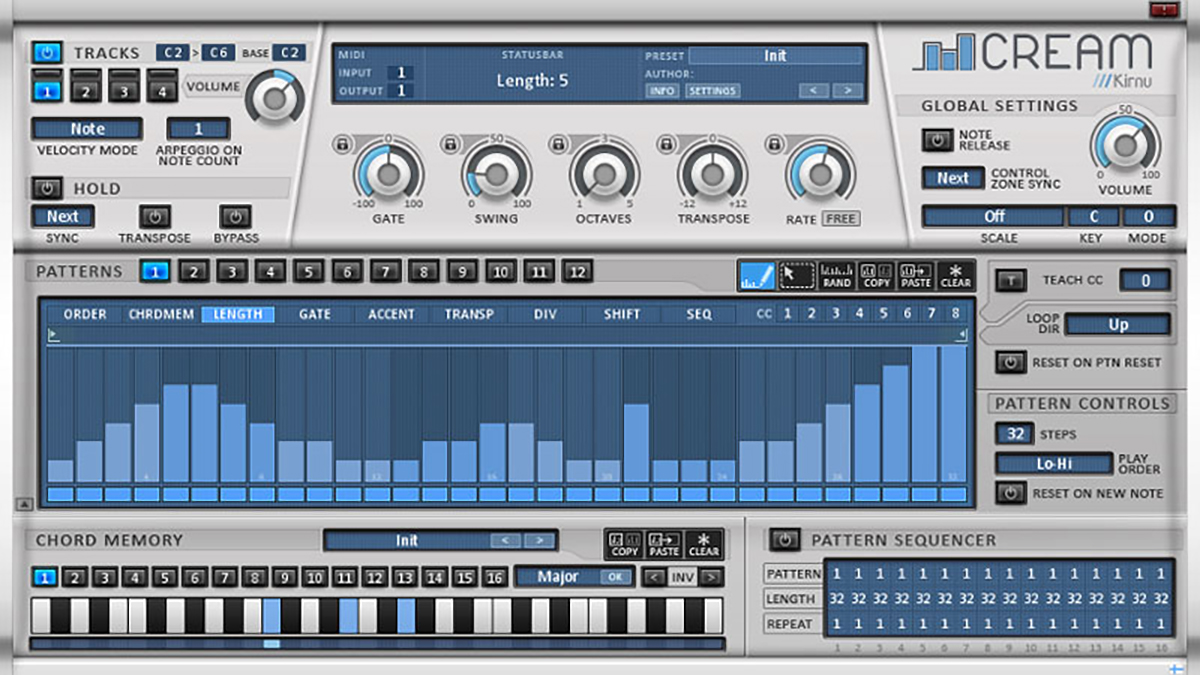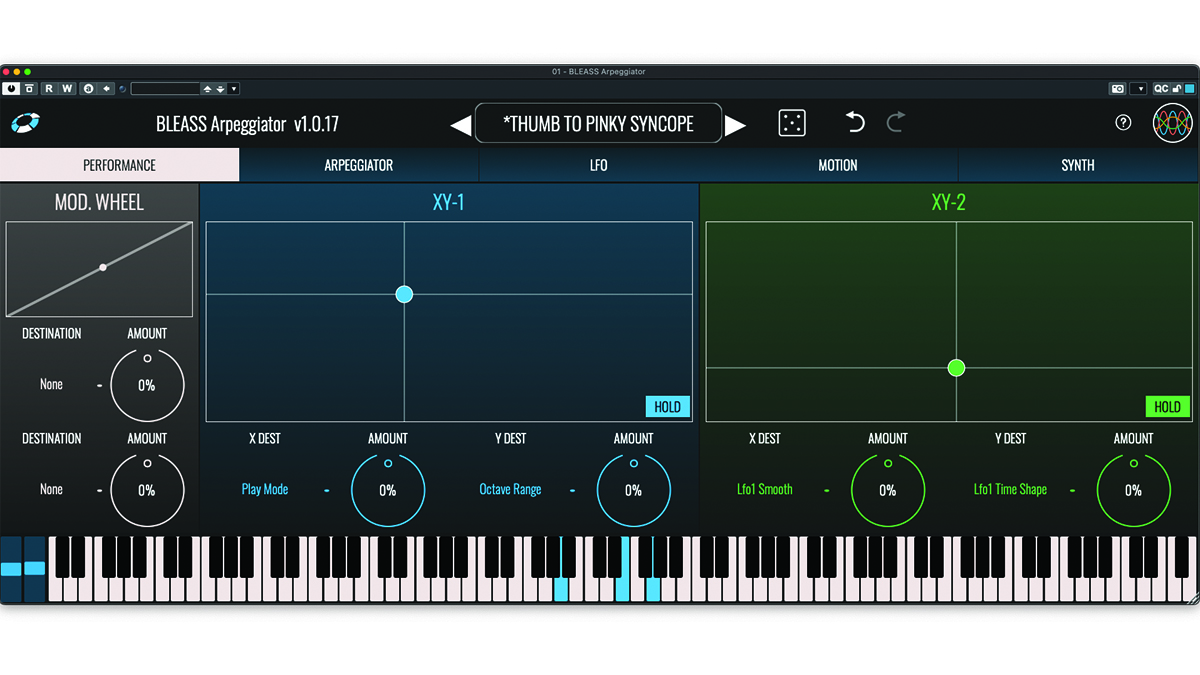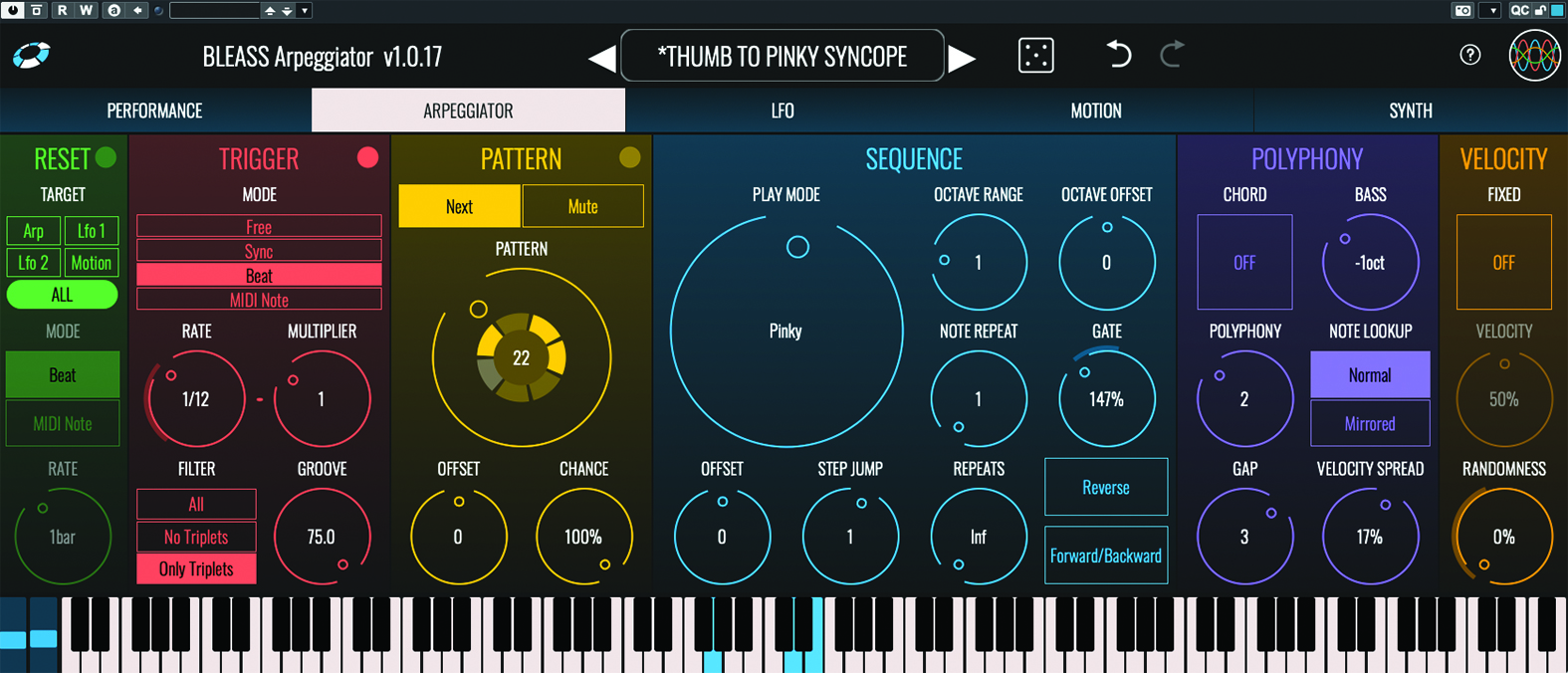MusicRadar Verdict
Successfully combines the intuitive playability of vintage arpeggiators with the complex patterns and harmonies of a modern pattern sequencer, then wraps the result in a hands-on synth-like interface.
Pros
- +
Easily creates complex arpeggios.
- +
Synthesizer-like modulators and performance controllers.
- +
Ideal for generative music.
Cons
- -
Modulators can’t map to built in synth or send MIDI CCs.
MusicRadar's got your back
BLEASS Arpeggiator: What is it?
Arpeggiators have been a common feature of synths for decades, but many modern examples can blur the lines between arpeggiator and pattern sequencer. Features that increase randomness are fine for generative music and the like, but programming these advanced arpeggiators is typically a longwinded process that lacks the spontaneous playability of a classic – yet basic – synth arpeggiator.
The new BLEASS Arpeggiator, developed in collaboration with French producer Canblaster, flips this state of affairs on its head, delivering complex arpeggio patterns via an intuitive, synth-like interface. To do this, the plugin breaks the arpeggiation process into a series of discrete stages.

BLEASS Arpeggiator: Performance and verdict
The first of these stages, Trigger, creates the underlying clock that drives the arpeggiator. This can run freely or be synced to your DAW, with-or-without groove and time multipliers applied. More tantalisingly, the Trigger section can respond to an incoming MIDI note, allowing you to step through an arpeggio using a pattern, or manually by pressing a key.

• Kirnu Cream
Taking a step-sequencer-style approach, Cream lets you create compelling arpeggio patterns .
• 510k Seqund
This innovative pattern sequencer has many probability-based easy polyrhythm features.
The Trigger section feeds to the Pattern section. This defines 62 different rhythmic patterns of varying step lengths, with each defining the steps that will and will not sound. Here also is a Chance setting that adds a randomising element to the pattern output, and this operates even if the Pattern selection is set to “Off”.
Each time the Trigger section sends a clock, the current pattern step is checked to see if it is active; if so, and if the Chance test is passed, a note will be generated. If no note is generated, then a Next/Mute setting determines whether Arpeggiator will move to the next position in the incoming note buffer (ie, the internal list of the notes you are playing), or will hold at the current buffer position.
What’s important to remember here is that what comes next, in this context, depends on the mode of the arpeggiator – that is, whether it is using an up, down, up-down, or whatever mode. This is configured in the plugin’s Sequence section, which provides a choice of 20 different modes, each determining the order in which the notes you play are used.
In addition, the Sequence section lets you specify note gate lengths, how many times a note will repeat before moving to the next note in the buffer, across how many octaves the sequence will repeat, and even the total number of times a sequence will play.
Want all the hottest music and gear news, reviews, deals, features and more, direct to your inbox? Sign up here.
Where most arpeggiators will output only a single note at a time, BLEASS Arpeggiator is fully polyphonic, with each step triggering up to four notes, and the option to add a bass note to each step. Alternatively, with the Chord mode enabled, the plugin will play simultaneously all of the notes you are holding, applying the rhythmic pattern, gate lengths and transpositions determined by the Trigger and Pattern sections.

Modulated arpeggios
BLEASS Arpeggiator’s synth-like credentials go much deeper than the arpeggio generator itself – there are modulators here too! The plugin recognises incoming Mod Wheel messages, which can be mapped to up to two destinations, and includes a pair of X-Y pads. These can route their X and Y values to different parameters, and are particularly fun if using a touchscreen, although they can of course be assigned to external controllers too.
A pair of LFOs, lifted directly from BLEASS’ Megalit synth, offer users the usual selection of waveforms, but these can be reshaped using smoothing, which controls the maximum rate of change of the LFO’s value, and time shaping, which ramps the playback rate across each waveform cycle. Also lifted from Megalit is the Motion Sequencer, a step sequencer that outputs modulation values.
Finding good ways to use these classic modulators in an arpeggiator context takes some experimentation, but there are some great examples included in the factory presets. The only shortcoming is that the modulators can’t target the built-in synth, and nor can their values be passed over to an external synth as MIDI CCs.
’Appy arps
Each instance of BLEASS Arpeggiator that you add to a project will create its own MIDI bus within your DAW, making it easy to send arpeggios to whatever synth you like (including external ones).
Alternatively, you can enable the plugin’s built-in synth, a simple FM-based affair that’s just right for creating the punchy, bright sounds that arpeggiate well. This is especially useful when it comes to the iOS app – just launch the app and start playing!
BLEASS Arpeggiator is quite unlike any other arpeggiator or pattern sequencer we’ve seen. Its synth-style controls make arpeggio creation an intuitive, creative, hands-on process that feels much more like playing an instrument than programming patterns. The price is a steal too, so be sure to grab the demo and give it a try.
MusicRadar verdict: Successfully combines the intuitive playability of vintage arpeggiators with the complex patterns and harmonies of a modern pattern sequencer, then wraps the result in a hands-on synth-like interface.
BLEASS Arpeggiator: The web says
"What sets the BLEASS Arpeggiator apart is its flexibility, which extends far beyond the capabilities of classic arpeggiators."
AudioNewsRoom
BLEASS Arpeggiator: Hands-on demos
BLEASS
SoundForMore Tutorials
The Sound Test Room
BLEASS Arpeggiator: Specifications
- macOS 10.9 and later (64-bit only) (including macOS 11 Big Sur and M1/M2 processors). VST3 (64-bit), Audio Unit, AAX.
- Windows 8 and later. VST3 (64-bit) / AAX.
- CONTACT: BLEASS



